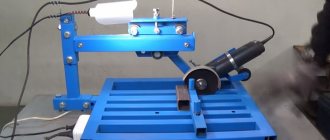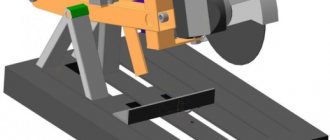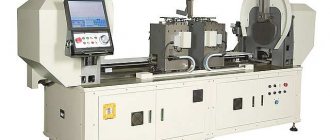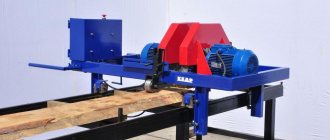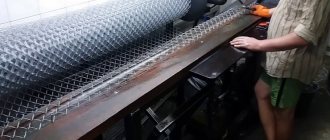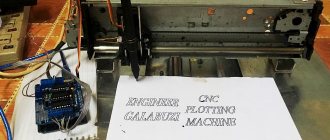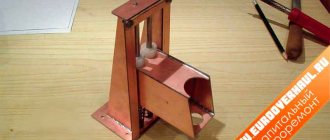Purpose of straightening cutting machine
Straight steel wire is used in many areas - mechanical engineering, for the construction of buildings and structures, and in the creation of complex metal structures. In this case, special requirements are imposed on its geometric parameters.
Since in most cases the blanks are supplied in coils, before using them it is necessary to perform the process of leveling and forming sections of a certain length. Manual labor will not allow this task to be completed with the required level of strength. To do this, straightening cutting machines should be installed.
They are designed to perform the following functions:
- alignment of steel bars. This is done using a system of shafts that are located on the feed and broach line;
- block with guillotine. Designed for cutting workpieces of a certain length.
During operation of the equipment, the diameter of the wire should not change. To do this, you need to correctly set the parameters of the broaching unit.
The material used to make the workpieces must be taken into account. Depending on this, the optimal cutting force is determined.
Conclusions and useful video on the topic
Video review of a manual pipe cutter for plastic pipes:
Video instructions for using a pipe cutter. The video shows how to properly process medium-diameter steel products with a pipe cutter:
Once you familiarize yourself with the types and types of pipe cutting equipment, choosing the right tool will not be difficult at all. If doubts remain, consultants from construction and hardware stores will be happy to help and tell you which device is best to purchase.
Do you have any questions about the topic of the article, have you found any shortcomings in the material, or can you provide valuable information? Please leave your comments in the block below.
Review of straightening machine designs
The standard equipment includes a correct frame with a shaft system, a pulling mechanism and a cutting unit. In addition to the standard function, such an installation can restore the original geometric dimensions of a straight wire.
An important point is the choice of the optimal model. Wire straightening machines are classified according to several parameters. First, the location of the leveling shafts. They can be installed both horizontally and vertically.
The following types of equipment are currently being manufactured:
- standard. The formation of an even workpiece occurs due to the influence of the correct frame on it. In this case, the rod is bent transversely;
- medium-speed with inverter. To increase productivity, the package includes three independent electric motors. Two of them are designed for broaching, and the third provides a high feed speed;
- medium-speed with a flying guillotine. The main difference is that instead of an electric drive, a hydraulic system is used for the guillotine. In this case, the cutting block moves along with the wire;
- special purpose. Used for processing non-round products. An important component is the end shape of the rollers, which depends on the initial parameters of the workpiece.
In addition, the wire straightening machine can be operated either manually or automatically. In the latter case, it is necessary to have a control unit that will regulate the feed speed and power of the electric motors.
Models with a flying guillotine are used on construction sites. They provide processing of products with a diameter of up to 18 mm.
Application
The twisted pipe making machine is a useful thing in various fields. For example, it can be used in furniture production, oddly enough. This is because twisted pipes can be used as structural elements of various furniture options. Modern furniture production technologies mean a non-standard approach and the use of high-quality and reliable materials. Twisted pipes in the furniture industry can be found as elements:
- tables;
- chairs;
- legs of upholstered furniture;
- bar counters;
- shelves;
- beds;
- shelving.
Having a small furniture production, a machine for making twisted pipes can give a new round in production: give rise to fresh ideas, expand the range of products.
Another industry where you can often find twisted pipes is construction, or rather the design of the exterior and interior of a building. In the first case, supports for a canopy, porch fencing, railings for stairs, balcony posts and much more can be made from twisted pipes; in the second, pipes have also found application. They can form a composition to decoratively complement the design, for example, as a stand for flowerpots. The machine for the production of twisted pipe will be useful in the production of stairs, structural decorative and functional elements of buildings. It can also be used in the production of awnings and gazebos.
In some cases, heated towel rails are made from twisted pipes. Due to the fact that the pipe is made of metal, it can be used as a cavity for filling with hot liquid, water or oil. And the twisted shape will create a more original appearance. Moreover, such pipes can be coated with special heat-resistant paint - this will provide additional solutions for bathroom design.
Machine Specifications
When analyzing proposals for ready-made equipment, special attention should be paid to its technical parameters. They directly depend on the initial characteristics of the material being processed. To do this, you need to familiarize yourself with the technical documentation and read reviews from owners.
The determining criterion for selection is the type of straightening machine, which must correspond to the above-described classifiers. Then the maximum and minimum diameter of the workpiece being processed is taken into account. To ensure normal operation and convenience of personnel, the overall dimensions should make it possible to install the complex on a specific site of the production facility.
Main technical characteristics of the straightening machine for steel rods:
- maximum and minimum diameter of the workpiece;
- feed speed, m/sec;
- length of cut rods, m;
- cutting accuracy, mm;
- overall dimensions and weight.
The speed of changeover for processing rods of other diameters is also taken into account. Additionally, it is recommended to purchase a set of shafts for alignment.
The video describes in detail the design and operating principle of the straightening machine:
Buy a bending machine with maximum benefit in
In addition to supplying equipment to our customers, we provide quality service:
- consulting support on operation and maintenance of the machine during the warranty period and after;
- supply of components and spare parts for the bending machine in the shortest possible time;
- free installation and commissioning of equipment supplied by us;
- Warranty and post-warranty repair of the bending machine if necessary.
All machines are delivered according to the agreed configuration and within the specified time frame with all accompanying documentation: instructions for connecting the bending machine and operating it in Russian, electrical diagram, drawings.
Didn't find the right model? Contact our specialists and explain your tasks. We can select a bending machine, the price and technical characteristics of which will suit even the most demanding customers.
Review of domestic straightening and cutting machines
Straightening cutting machines are used to pre-align the wire. We will look at their work and compare the machines SMZh-32, GD-162 and others.
Any enterprise that is engaged in the mass production of welding electrodes, or uses reinforcing bars for reinforced concrete on a mass scale, has at least one straightening and cutting machine for wire as part of its production equipment. Leveling and cutting machines are even more productive, the operation of which does not require the constant presence of an operator at the workplace.
Device of straightening-cutting machines
The straightening and cutting machine consists of the following components:
- Electric motor;
- V-belt transmission;
- Reception shaft with flywheel;
- Electro-pneumatic friction clutch for drive engagement;
- Inertial unwinder;
- Feeding mechanism;
- Transfer mechanism;
- Ejection mechanism;
- Camshaft with bevel gear and control cams;
- The main crank shaft, on which a slider with a movable knife is mounted;
- Beds with a tool block where a fixed knife is installed;
- Adjustable swing type stop;
- Control unit.
The editing-cutting work cycle goes like this. The feed material from the unwinder periodically moves to the feed mechanism. The rollers installed there first straighten and then feed the material all the way into the cutting matrix. After this, the main drive of the machine is turned on: the movable knife cuts the workpiece to the required length and transfers it to the matrix. A calibration punch mounted in the slide pushes the workpiece into the die, where the upper and lower ends are calibrated. When the slider begins its reverse stroke, the rod is pushed out of the matrix and falls under its own weight into the container. The working cycle is automatically repeated until the unwinder runs out of wire.
Prices for straightening and cutting machines of domestic production range from 400 thousand rubles. up to 500 thousand rubles, depending on the size of the equipment.
Detailed video on how to make a proper cutting machine with your own hands:
Spun straight frame
The spun straightening frame rotates around the longitudinal axis and transmits bending loads in an overlapping spiral pattern, which ensures a high degree of straightness of the material being passed. The principle is that the circular and longitudinal effect of the die on the wire, transforming it into a spiral or wave, disappears when the wire enters the next die, blocking the hole in the previous one, and as a result, the output is a straightened, straight wire. Straightness depends on various factors, mainly feed, speed and the condition of the correct equipment.
Basic bending methods
If it is necessary to perform a small amount of work, then hand tools are used to bend the wire. For bending soft metal materials or when the wire diameter does not exceed 3 mm, pliers or round nose pliers are used. These tools allow you to securely clamp a part of the product in one tool, and use another to bend the wire to the desired angle.
In this way, you can bend the material using a carpenter's vice. In this case, the wire is fixed in a vertical position, and the change in direction is also carried out using pliers or any other clamping device or mechanism.
If it is necessary to make a rounded bend, then for this purpose any rod of suitable diameter is used, which is also clamped in a vice. A rounded bend will need to be made when making springs from elastic wire yourself.
To do this, it is enough to clamp a rod or pipe of a suitable diameter in a vice, fix the end of the wire on one side, and use pliers to wind the wire the required number of turns.
If the wire has to be bent too often, then the most correct solution would be to purchase special devices or machines.
Tools for bending this material are a design in which the wire is clamped and bent using human muscle power. Machine tools usually use electric drives, and for the manufacture of complex products such machines are equipped with electronic controls.
Rules for work
Wire bending is not a complicated process, but to work effectively with this material you must adhere to the following rules:
- For work, you must use gloves made of thick fabric.
- Use only working tools and automatic machines.
- If a vice is used to perform this operation, then before starting the process, you must make sure that the workpiece is securely fixed.
- Before bending, the workpiece should be leveled.
Following these recommendations will help prevent scraps and injuries in the event of a sudden release of material from the holding device. You should also take care of the wiring and proper grounding when using machines that run on electricity.
Equipment use
If the volume of work is large enough, then equipment equipped with an electric motor will allow you to perform a large number of operations. The use of machines will significantly increase labor productivity, but at the initial stage it will be necessary to make some efforts to study the process of operation of a wire bending machine.
The most economical machine for bending wire is considered to be coil equipment, in which the material is supplied from bulk coils.
The process of bending wire on such equipment is carried out in the following order:
- The wire from the coil is fed to a roller mechanism, which aligns the material.
- The straightened wire enters the bending mechanism.
- At the next stage, bending and separation of the wire products occurs.
- After cutting the finished product, the process is repeated.
To make wire bending work as comfortable as possible, CNC machines are used.
Despite the significant cost of such equipment, the return on investment in a business occurs within a few months. Machines equipped with a microprocessor allow not only to fully automate the process, but also to carry out welding work on curved products.
Types of bending machines
There are 2D and 3D bending machines. The former are used for the manufacture of simple flat products: hooks, hangers, wire frames, etc. 3D wire machines are universal bending machines suitable for the production of almost any wire product: trays, brackets, baskets, etc. Three-dimensional bending is made possible thanks to the presence of a rotary console. Spring winding machines should be included in a separate group. Their use allows you to make springs of various diameters and with different numbers of turns in a matter of seconds. Based on the type of raw materials used, there are:
- sheet metal bending machines;
- machines for bending reinforcement;
- bending machines for profile pipes;
- tape bending machines;
- wire bending machines.
Our website presents machines for working with metal strip, pipe, wire and fittings, as well as a specialized machine for making letters from aluminum strip for signs.
